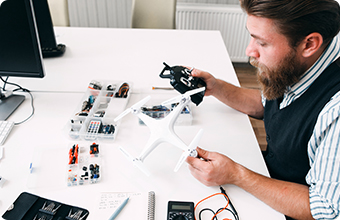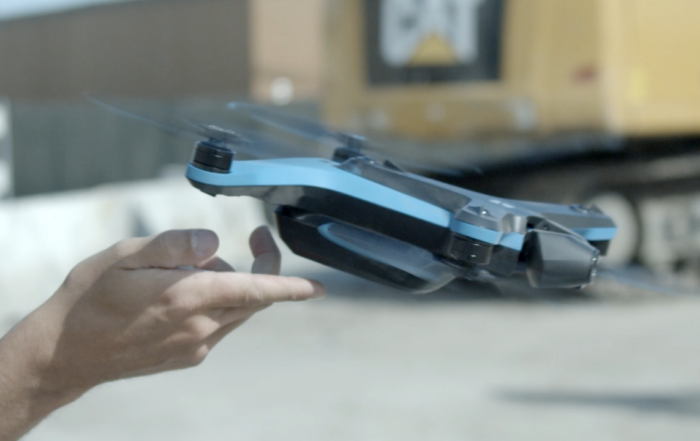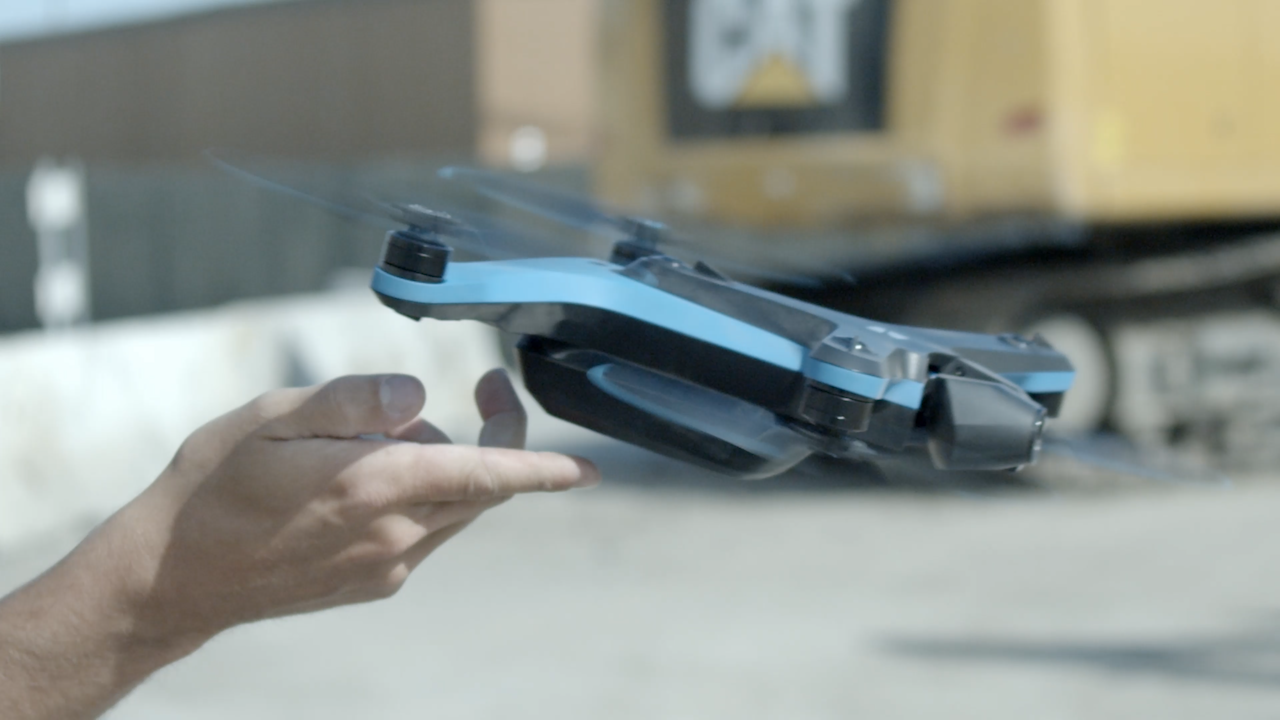The Recreational UAS Safety Test (TRUST)
The Recreational UAS Safety Test (TRUST) What is TRUST? The law requires that all recreational flyers pass an aeronautical knowledge and safety test and provide proof of passage if asked by law enforcement or [...]
Recreational Flyers & Modeler Community-Based Organizations
You are considered a recreational user if you fly your drone for fun. It is important to know when and where you can fly and how to register your drone. New Changes to Recreational Drone [...]
Recreational Flyers & Modeler Community-Based Organizations
Recreational Flyers & Modeler Community-Based Organizations You are considered a recreational user if you fly your drone for fun. It is important to know when and where you can fly and how to register [...]
Become a Drone Pilot
In order to fly your drone under the FAA's Small UAS Rule (Part 107), you must obtain a Remote Pilot Certificate from the FAA. This certificate demonstrates that you understand the regulations, operating requirements, [...]
Public Safety and Law Enforcement Toolkit
Public Safety and Law Enforcement Toolkit Webinar: Drone Safety: It's the Law The use of drones in our nation's airspace is rapidly increasing, which raises both opportunities and challenges for public safety and [...]
1. Not following the rules and regulations
This is one mistake even experienced pilots make. Besides being a camera, a drone is technically an airplane, so it must adhere to airspace regulations. It was a toy drone, and I thought I could get away with it, but I lost the drone and was fined for flying without authorization. Familiarizing yourself with the rules and regulations for flying drones in your area is essential. These may include altitude and distance restrictions and restrictions on flying near airports or other sensitive areas. If you are going on vacation and want to bring the drone, familiarize yourself with the local and travel laws and the documentation you will need. You wouldn’t want to be caught with a drone at the airport in a country that has banned drones.
2. Powering on in the wrong sequence
This may seem harmless, but you could destroy your drone if you do it wrongly. For most drones, you should power on the drone before powering on the controller. Why? If the drone acts out, you can take control of it with the controller.
3. Not reading the manual
Whether a new pilot or an experienced pilot, it is essential to thoroughly read and understand the manual for your specific drone before flying it.
The manual will provide important information on operating the drone safely and effectively. If you crashed your drone and could have avoided it by reading the manual, you could void your warranty. Besides, most of the questions people ask when trying to troubleshoot a drone are answered in the manual.
4. Not registering your drone
In many countries, it is required by law to register your drone with the appropriate aviation authority unless it fits in the toy drone category.
This is typically done to ensure that all drones in the airspace are being operated safely and responsibly and to help authorities keep track of drones in case of any incidents or accidents. In the United States, you need to register all drones weighing more than 0.55 pounds or drones that are used for professional work but weigh less than 0.55 grams. Below are some reasons why registering your drone is important:
- Safety: Registering your drone helps ensure that it is being operated safely and responsibly and can help authorities identify the drone’s operator in case of an accident or incident.
- Liability: If you are operating a drone for any purpose other than recreational use, you may be held liable for any damage or injuries that result from your drone’s operation. Registering your drone can ensure that you are aware of your responsibilities and can protect you from liability in case of any incidents.
5. Flying in bad weather
You may be required to fly a drone in rain or snow to complete a task, or you want to do it just for fun. Either way, most drones aren’t built for it.
Below are some reasons why you should avoid flying in bad weather.
- Reduced visibility: Bad weather conditions, such as rain, fog, or snow, can significantly reduce visibility, making it difficult to see the drone and control it. This can increase the risk of accidents and collisions with other aircraft or birds.
- Damage to the drone: Bad weather can also increase the risk of damage to the drone. High winds, lightning, rain droplets, or hail can all damage the drone or its components, potentially rendering it inoperable. While some drones may have a high IP rating, most aren’t waterproof and shouldn’t be exposed to wetness.
- Interference with GPS signals: Bad weather can also interfere with GPS signals, affecting the drone’s ability to navigate and maintain its position. This can make it difficult to accurately control the drone and increase the risk of accidents.
- Legal restrictions: In some countries, specific laws or regulations may prohibit flying drones in certain weather conditions, such as high winds or heavy rain. The FAA doesn’t explicitly prohibit people from flying in bad weather, but it does advise pilots to exercise caution and consider the weather when planning their flights. Apps like B4UFLY and AirMap are good sources of weather information.
If you find yourself in strong winds, avoid flying against the wind since you will cause the drone to work harder and deplete its battery.
6. Losing sight of the drone
Flying the drone beyond the line of sight may be tempting, especially when you want to test its range.
Other times, you may lose sight of your drone because it went behind a tree or building or because you flew too high and can’t see it anymore.
Either way, below are reasons why you should never lose sight of your drone:
- Safety: Maintaining a line of sight with your drone allows you to respond to any emergencies or unexpected changes in the drone’s flight path, which can help to prevent accidents or incidents.
- Regulatory requirements: In many countries, maintaining a line of sight with your drone is a requirement for legal drone operation. This helps to ensure that the drone is being operated safely and responsibly and that it is not posing a risk to other aircraft or people on the ground.
- Navigation: Maintaining a line of sight with your drone allows you to see the drone’s location and orientation, which can help navigate the drone and maintain control. It also allows you to see the drone’s orientation in relation to its surroundings, which can help you to maintain situational awareness and make better-informed decisions about the drone’s flight path.
- Interference with other aircraft: Flying a drone too high can also interfere with other aircraft in the airspace, which can pose a safety risk. Drones must give way to other aircraft and not interfere with their operation.
- Connection strength: When you fly too far from the controller, you risk losing the connection between the drone and the controller due to interference, tall objects along the path, or the transmission protocol. When the connection is lost, you can’t control the drone back and can’t even initiate RTH.
Just because a drone has a range of 5 miles or more doesn’t mean you should fly the whole 5 miles away. That only means they will have a strong connection for shorter-range flights.
7. Flying the drone backward
There are situations where pilot must fly in reverse to take a shot or when trying to orient the drone.
However, this often doesn’t end well due to the following reasons:
- Reduced visibility: Flying a drone backward can significantly reduce the pilot’s visibility of the drone and its surroundings, making it more difficult to control the drone. This can increase the risk of accidents.
- Loss of situational awareness: Flying a drone backward can also make it more difficult for the pilot to maintain situational awareness and understand the drone’s position and orientation in relation to its surroundings. This can increase the risk of losing control of the drone or flying it into obstacles.
- Involuntary movements: Flying a drone backward can also make it more challenging to control its movements, as the controls may not be intuitive when flying in this direction. This can lead to unintended movements or changes in the drone’s flight path.
8. Not checking the drone’s battery
There’s the battery level advertised by the manufacturer, which is not always accurate in actual flight.
That’s because you could be flying against the wind, the batteries could be damaged, or the drone could carry extra weight causing it to drain the battery faster.
You need to be aware of the drone’s actual flight time and take that into account as you fly.
Pay attention to the wind and the drone app’s alerts as the battery power gets depleted, and make sure you have enough time to fly the drone back.
If you don’t, the battery may get depleted along the way, and the drone may land and crash into something or even land in a waterbody, and you may never find it.
* Start flying the drone back at 40 to 50% battery level to avoid such issues.
9. Not performing pre-flight checks
Flight checks are standard with manned aircraft, but they are also crucial and should be addressed by drone pilots.
Performing pre-flight checks is an important step in preparing to fly a drone, as it helps to ensure that the drone is ready for flight and that the pilot is familiar with its capabilities and limitations.
Pre-flight checks can help to identify any issues or problems with the drone that could affect its performance or safety and can help the pilot to make any necessary adjustments or repairs before takeoff.
Some examples of pre-flight checks that a drone pilot should perform include the following:
- Checking the battery: Ensuring that the drone has enough charge to complete the planned flight is important for the safety of the drone and its surroundings.
- Inspecting the drone: The pilot should inspect the drone for any visible damage or defects that could affect its performance or safety.
- Checking the controls: The pilot should ensure that the drone’s controls are functioning correctly and that the drone responds as expected to input.
- Reviewing the flight plan: The pilot should review the planned flight path and any relevant airspace restrictions or other considerations that may affect the flight.
10. Not knowing your drone’s stopping distance
A drone pilot needs to know the stopping distance of their drone, as this can help them to make informed decisions about the drone’s flight path and to avoid accidents or incidents.
The stopping distance of a drone refers to the distance that the drone will travel before it comes to a complete stop and can be affected by several factors, including the drone’s speed, weight, the area it’s flying in, and control sensitivity or the mode you are flying in.
Knowing the stopping distance of your drone can be helpful in several ways:
- Safety: Knowing your drone’s stopping distance can help you avoid accidents or incidents by ensuring that you do not fly the drone too close to obstacles or people.
- Navigation: Knowing the stopping distance of your drone can also help navigate the drone and plan its flight path. You can use this information to determine how close you can safely fly the drone to objects or other objects and ensure you have enough room to bring the drone to a stop if necessary.
11. Not updating the firmware
There are situations when new firmware updates may cause bugs, but that doesn’t mean you should always avoid them entirely.
Keep your drone’s software and firmware up to date because it can help improve the performance of your drone and fix any bugs or issues that may be present.
Updating the software and firmware can also add new features and functionality to your drone, allowing you to get more out of it and use it in new and exciting ways.
Keeping your drone’s software and firmware up to date can also help ensure that it is compatible with any new devices or technologies you may use.
Regularly updating the software and firmware on your drone can also help improve its security and protect it against any potential vulnerabilities that may have been discovered.
12. Not updating the return to home location and height
It’s easy to forget to update the Return-to-Home (RTH) parameters; use your checklist.
The RTH feature allows your drone to automatically fly back to its starting point if it loses contact with the remote controller or encounters other issues that may prevent it from continuing to fly safely. However, it relies on GPS.
Before you fly, ensure it has registered the home point or the takeoff point since that’s where it will fly back to. If you fail to update this, it may end up landing in a different location.
Updating the RTH is also crucial if you are moving around a lot, be it in a boat or outdoor flying, and have to keep shifting locations. In such a case, constantly update the RTH to the new location.
Besides updating the RTH location, you should also update its height. When you initiate RTH, the drone flies to the set height before flying back home.
When setting this height, please pay attention to the obstacles around you and ensure the drone flies above them during RTH to avoid crashing into them.
13. Flying too close to wildlife
You may have seen people fly close to birds, alligators, or other wildlife and thought it was fun, but it’s not. Below are some reasons why you should always keep a distance from wildlife:
- Disturbance: Flying a drone near wildlife can disturb and stress animals, disrupting their natural behavior and potentially causing harm. There have been cases where drones flew into birds or disturbed them, distracting them from their eggs and causing them not to hatch.
- Habitat destruction: Drones can also cause physical damage to wildlife habitats, such as by crashing into trees or other objects.
- Legal issues: In many areas, it is illegal to fly a drone close to wildlife or to disrupt their natural behavior.
- Safety: Flying a drone close to wildlife can also pose a safety risk to the operator and others nearby. Animals may react aggressively or unpredictably to the presence of a drone, which could result in injury or damage. This video shows a drone that flew too close to a crocodile causing the crocodile to attack and destroy it.
14. Flying over people or property
For many, drones are a source of a lot of anxiety. People become increasingly worried when they see drones over their property or at a park.
And their worry is warranted because drones have cameras powerful enough to take clear pictures of someone’s backyard and the people in it or the people in a park. If it crashes, it could damage the property or injure people.
As such, it’s important to avoid flying too close to people or property.
You will not only potentially cause discomfort or damage, but you may also break some laws that could lead to hefty fines or even get your license revoked.
If you are required, or just to be a good neighbor, make sure you get permission from the relevant authority and consent from the relevant parties.
You should also pay attention to local events, temporary restrictions in the case of an event, and the local laws regarding flying close to or over crowds.
15. Not having adequate insurance
Many pilots ignore insurance, but if you fly a lot, especially as a commercial pilot, you need proper insurance for your drone since it protects you financially in the event of an accident or other unexpected event.
Drones can be expensive to purchase and maintain, and repairs or replacement costs can add up quickly if something goes wrong. Having insurance can help cover these costs and ensure that you are not financially responsible for any damage or losses that may occur.
In addition, drones can pose a variety of risks and liabilities, such as causing damage to property or injury to people. Adequate insurance can cover these types of risks and provide financial protection in the event of an accident.
It is always a good idea to carefully review the terms and coverage of your insurance policy to ensure that it meets your specific needs and provides the level of protection you require.
16. Not seeking out additional training and education
As a drone pilot, it is essential to have the necessary training and knowledge to operate drones safely and responsibly and to continuously update this knowledge as time goes by.
This includes understanding the rules and regulations that apply to drone flight and a good understanding of how to fly the drone itself.
Several different types of training may be required for drone pilots, depending on the specific operation they will be conducting and the drone they will be flying. Some examples of additional training that may be required include:
- Safety training: This may include training on how to safely operate the drone and avoid accidents or incidents.
- Flight training: This may include training on how to fly the drone, including takeoff and landing procedures, navigating the drone, and responding to emergencies.
- Regulatory training: This may include training on the rules and regulations of drone flight, such as airspace restrictions and requirements for obtaining permission to fly in certain areas.
- Specific operation training: This may include training on how to conduct specific types of drone operations, such as inspecting pipelines, surveying land, or capturing aerial imagery.
17. Flying near airports or other sensitive areas
There are several reasons why it is generally not recommended to fly a drone near airports, military spaces, or other sensitive areas:
- Safety: Flying in such areas poses a safety risk, as these areas may have a higher concentration of aircraft or other potential hazards. This can increase the risk of accidents or incidents.
- Legal restrictions: In many countries, it is illegal to fly a drone near airports, military spaces, or other sensitive areas without obtaining prior permission. Violating these laws can result in fines or other penalties.
- Interference with other operations: Flying a drone in sensitive areas can also interfere with the operations of these facilities, which can disrupt their activities and potentially compromise security.
- Privacy concerns: Flying a drone in sensitive areas can also raise privacy concerns, as the drone may capture images or other sensitive information.
Each region has regions designated as No-Fly zones and what’s required to fly in them. Make sure you are aware of these zones.
18. Flying at night
You must have the necessary authorization, equipment, and skill to fly a drone at night. Why?
- Reduced visibility: Flying a drone at night can significantly reduce the pilot’s visibility of the drone and its surroundings, making it more challenging to see the drone and navigate it safely.
- Legal restrictions: Some specific laws or regulations in many countries prohibit or restrict flying drones at night. These restrictions may be in place to help ensure the safety of the drone and its surroundings.
- Interference with other aircraft: Flying a drone at night can also interfere with other aircraft in the airspace, which can pose a safety risk.
- Reduced performance: Flying a drone at night can also affect its performance. Some drones may need to be equipped with sufficient lighting or other features to enable safe operation in low-light conditions.
19. Flying when distracted or under the influence
You should not underestimate the level of concentration and alertness required to fly a drone.
You need to be aware of your surroundings at all times to note any changes in weather, flight path, the drone, and related equipment, etc. it only takes a few seconds and a few wrong moves to crash the drone.
Another reason you should never be distracted is the in-app warnings about your drone, exposure settings, areas with restrictions, when you fly too far or when the connection is weak, etc.
On the other hand, being under the influence impairs your judgment, making it difficult to make rational decisions in an emergency.
20. Not maintaining the drone
As mentioned earlier, a drone is an expensive gadget; one mistake you can make is not maintaining it properly.
Maintenance includes taking good care of the batteries, checking the motors and replacing them when necessary, checking the drone before flying to ensure everything is okay, conducting regular firmware updates, and flying the drone within the guidelines provided by the manufacturer.
Regular maintenance enhances the drone’s performance, prolongs its life, saves you money on replacements and repairs, and ensures the drone is safe for everyone and every property around it at any time.
21. Flying too close to power lines
You may not know this, but power lines are bad news for drones.
For starters, they have electromagnetic interference, which will interfere with the drone’s communication with the controller and even alter its compass.
Secondly, powerlines are sometimes thin; if you fly too far, you may not see them and end up crashing into them.
Drone obstacle sensors may also be unable to detect them, as it happens with thin tree branches and leaves.
Avoid taking off when close to power lines, and fly the drone within VLOS so that you are aware of all the objects around.






